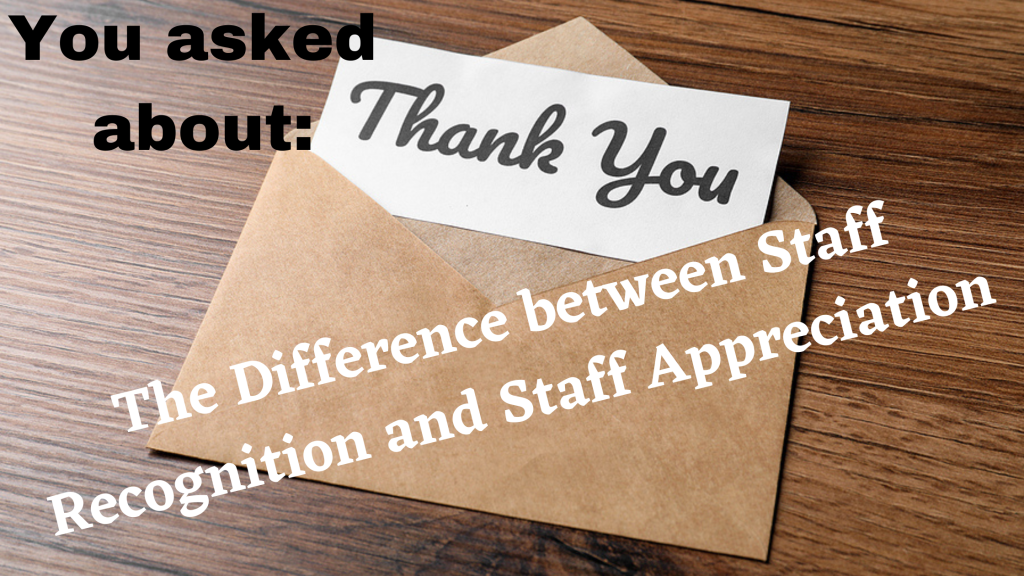The Question: How is staff recognition different from staff appreciation?
The Answer: The answer depends on your personal definition of these words. That said, most experts in the field seem to agree with my thinking that appreciation is an emotion that motivates us to recognize others for how they contribute and what they achieve.
In my new book, Thanks, Again!, I ask “What is ‘Staff Recognition?” Several sources that I quote mention appreciation when defining recognition.
One, the Random House College Dictionary, says recognition is “Appreciation of achievement, merit, services, etc., or an expression of this.”
Sue Glasscock and Kimberly Gram (Workplace Recognition: Step-by-step examples of positive reinforcement strategy) say, in part, that the purpose of recognition is, “To acknowledge and appreciate those behaviours, practices and actions that move us toward our business goals and objectives.”
Dr. Bob Nelson (Recognizing and Engaging Employees for Dummies) writes that, “Recognition can take the form of acknowledgement, approval, or the expression of gratitude. It means appreciating someone for something he or she has done for you, your group or your organization.”
When referring to staff recognition, I stress that it must be Genuine if recipients are to find it meaningful. Recognition must be inspired by a sincere sense of appreciation for what someone did.
Gary Chapman and Paul White (The 5 Language of Appreciation in the Workplace) have a different view of recognition and appreciation. “We believe that there is a distinct difference between recognition and appreciation … we believe the focus of recognition and rewards is too narrow and has distinct limitations.”
One of the limitations they refer to is the emphasis on performance. “While recognition focuses primarily on performance or the achievement of certain goals, appreciation focuses on the value of the individual,” Chapman and White write. “While recognition focuses on what the person does, appreciation focuses on who the person is.”
Another limitation they cite is that most rewards programs include only two languages of appreciation (Words of Affirmation and Tangible Gifts). They also note that recognition programs take “an impersonal, top-down corporate policy approach. Employees know that the program is generated by upper-level management, rather than being personal and individualized.” Finally, they say that reward programs come with a significant cost.
If we accept Chapman and White’s view of what staff recognition is, I would agree with their conclusion that, “the vast majority of employee recognition programs aren’t working.”
I see staff recognition differently. Done properly, staff recognition demonstrates that people are valued for who they are and appreciated for how they contribute and what they achieve. It helps create a workplace where all feel they belong and where they want to stay.
Recognition need not be expensive and is most meaningful if delivered by immediate supervisors and peers. Thanks, Again! emphasizes simple, inexpensive ways that frontline leaders can recognize staff.
Chapman and White write that recognition and reward programs exclude “40 to 50 per cent of employees whose language of appreciation is Quality Time (“giving the person your focused attention”) or Acts of Service (“providing assistance to one’s colleague”).”
This need not be the case if leaders get to know staff members as individuals with unique interests, goals and recognition preferences, which leads to expressing appreciation in Appropriate ways.
==
Download a sample theme from Thanks, Again! More Simple, Inexpensive Ways for Busy Leaders to Recognize Staff (Staff Recognition’s Number One Tool: Thank-you Notes) when you sign up for updates on plans for this fall’s book launch. Learn how you can receive an autographed copy of Thanks, Again! and other valuable perks when you contribute to my crowdfunding campaign for this book.



